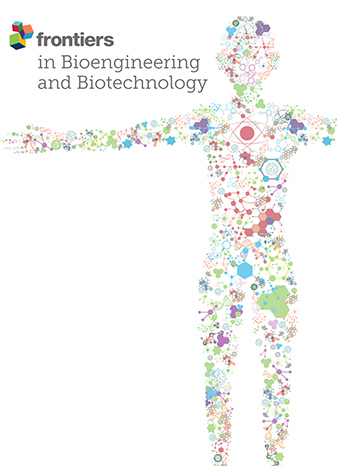Enabling 3D bioprinting of cell-laden pure collagen scaffolds via tannic acid supporting bath
IF 4.3
3区 工程技术
Q1 BIOTECHNOLOGY & APPLIED MICROBIOLOGY
引用次数: 0
Abstract
The fabrication of cell-laden biomimetic scaffolds represents a pillar of tissue engineering and regenerative medicine (TERM) strategies, and collagen is the gold standard matrix for cells to be. In the recent years, extrusion 3D bioprinting introduced new possibilities to increase collagen scaffold performances thanks to the precision, reproducibility, and spatial control. However, the design of pure collagen bioinks represents a challenge, due to the low storage modulus and the long gelation time, which strongly impede the extrusion of a collagen filament and the retention of the desired shape post-printing. In this study, the tannic acid-mediated crosslinking of the outer layer of collagen is proposed as strategy to enable collagen filament extrusion. For this purpose, a tannic acid solution has been used as supporting bath to act exclusively as external crosslinker during the printing process, while allowing the pH- and temperature-driven formation of collagen fibers within the core. Collagen hydrogels (concentration 2–6 mg/mL) were extruded in tannic acid solutions (concentration 5–20 mg/mL). Results proved that external interaction of collagen with tannic acid during 3D printing enables filament extrusion without affecting the bulk properties of the scaffold. The temporary collagen-tannic acid interaction resulted in the formation of a membrane-like external layer that protected the core, where collagen could freely arrange in fibers. The precision of the printed shapes was affected by both tannic acid concentration and needle diameter and can thus be tuned. Altogether, results shown in this study proved that tannic acid bath enables collagen bioprinting, preserves collagen morphology, and allows the manufacture of a cell-laden pure collagen scaffold.通过单宁酸支撑浴实现含有细胞的纯胶原支架的三维生物打印
制造含有细胞的仿生支架是组织工程和再生医学(TERM)战略的支柱,而胶原蛋白是细胞的黄金标准基质。近年来,挤压三维生物打印技术凭借其精确性、可重复性和空间控制性,为提高胶原蛋白支架的性能提供了新的可能性。然而,由于胶原蛋白储存模量低、凝胶化时间长,这严重阻碍了胶原蛋白丝的挤出和打印后所需形状的保持,因此纯胶原蛋白生物墨水的设计是一项挑战。本研究提出了以单宁酸为介质的胶原蛋白外层交联策略,以实现胶原蛋白丝的挤出。为此,我们使用单宁酸溶液作为支撑浴,在打印过程中专门用作外部交联剂,同时允许在核心内形成由 pH 值和温度驱动的胶原纤维。胶原水凝胶(浓度为 2-6 毫克/毫升)在单宁酸溶液(浓度为 5-20 毫克/毫升)中挤出。结果证明,在三维打印过程中,胶原蛋白与单宁酸的外部相互作用可实现长丝挤出,而不会影响支架的体积特性。胶原蛋白与单宁酸的暂时相互作用形成了一层膜状外层,保护了核心,胶原蛋白可以在核心中自由排列成纤维。打印形状的精度受单宁酸浓度和针直径的影响,因此可以进行调整。总之,本研究的结果证明,单宁酸浴可以实现胶原蛋白生物打印,保存胶原蛋白形态,并允许制造含有细胞的纯胶原蛋白支架。
本文章由计算机程序翻译,如有差异,请以英文原文为准。
求助全文
约1分钟内获得全文
求助全文
来源期刊

Frontiers in Bioengineering and Biotechnology
Chemical Engineering-Bioengineering
CiteScore
8.30
自引率
5.30%
发文量
2270
审稿时长
12 weeks
期刊介绍:
The translation of new discoveries in medicine to clinical routine has never been easy. During the second half of the last century, thanks to the progress in chemistry, biochemistry and pharmacology, we have seen the development and the application of a large number of drugs and devices aimed at the treatment of symptoms, blocking unwanted pathways and, in the case of infectious diseases, fighting the micro-organisms responsible. However, we are facing, today, a dramatic change in the therapeutic approach to pathologies and diseases. Indeed, the challenge of the present and the next decade is to fully restore the physiological status of the diseased organism and to completely regenerate tissue and organs when they are so seriously affected that treatments cannot be limited to the repression of symptoms or to the repair of damage. This is being made possible thanks to the major developments made in basic cell and molecular biology, including stem cell science, growth factor delivery, gene isolation and transfection, the advances in bioengineering and nanotechnology, including development of new biomaterials, biofabrication technologies and use of bioreactors, and the big improvements in diagnostic tools and imaging of cells, tissues and organs.
In today`s world, an enhancement of communication between multidisciplinary experts, together with the promotion of joint projects and close collaborations among scientists, engineers, industry people, regulatory agencies and physicians are absolute requirements for the success of any attempt to develop and clinically apply a new biological therapy or an innovative device involving the collective use of biomaterials, cells and/or bioactive molecules. “Frontiers in Bioengineering and Biotechnology” aspires to be a forum for all people involved in the process by bridging the gap too often existing between a discovery in the basic sciences and its clinical application.
文献相关原料
| 公司名称 | 产品信息 | 采购帮参考价格 |
|---|
 求助内容:
求助内容: 应助结果提醒方式:
应助结果提醒方式:


